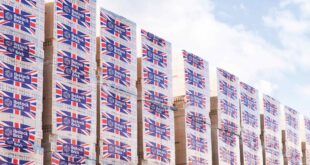Bill Price, National Technical Manager at Tarmac Cement talks a lot of hot weather
Britain has been basking in another week of hot sunshine, with forecasters now predicting that 2018 could be our hottest year on record. Great news for many, but those of us in the building and construction industry may be a little less enthused by this prospect.
Not forgetting the personal risk of sunburn, what does the very real possibility of this unprecedented spell of hot weather continuing for the rest of the summer, mean for masonry construction? And what advice can merchants offer to those working with bricks and blocks in the heat?
Hot weather can throw up some real challenges – not only is workability greatly reduced, but you will also need to think carefully about the impact that the heat can have upon the cement setting and hardening process.
During hardening , the cement present in mortar undergoes a chemical hydration reaction with water – this reaction is essential for normal strength development of the cement, and hence the mortar, it does not ‘dry out’! . However, higher temperatures, direct sunlight and drying winds will, naturally, increase the likelihood of water evaporating from the surface. Critically, if mortar dries too quickly, this hydration process is interrupted and t not only will it shrink and crack, but it will also be weak, dusty and porous. This will result in a marked reduction of strength.
One simple measure that your customers can take is to ensure an adequate that the mortar is kept in a moist condition after it has set and starts to harden. This is called ‘Curing’. Common curing methods can include covering work with damp hessian or plastic sheeting to prevent evaporation (being sure that this does not mark the concrete!), pre-wetting of surrounding porous materials or, for horizontal surfaces, misting with light water spray at regular intervals (for use especially with mortars and renders).
However, it’s not only the mortar that needs consideration. In extreme heat, the bricks themselves are drier and will suck more water than usual out of the freshly placed mortar. Too much suction will result in poorly hydrated, low strength mortar. Storing bricks in the shade will prevent this and dampening the bricks before use will also help to control the increased suction.
A good bricklayer will also need to think about the working conditions. Simple measures could include using cool, mains water where possible instead of storing water in containers ready for use. If it’s not possible to use mains water, it is vital that stored water is kept cool. Avoiding making up unnecessary large batches of mortar will also help minimise evaporation. For smaller jobs, Tarmac’s plastic tubs of Blue Circle products allow a small amount of product to be used and the rest sealed away and stored – preferably in the shade! And, although it may sound obvious, you should consider scheduling your activities to avoid hot afternoon periods.
Careful planning and preparation is important to ensure successful masonry work this summer. It could be the key to a seamless summer of building– and will leave your customers with more time to enjoy the sun.
 Builders Merchants Journal – BMJ Publishing to Builders Merchants and the UK merchanting industry for more than 95 years
Builders Merchants Journal – BMJ Publishing to Builders Merchants and the UK merchanting industry for more than 95 years



